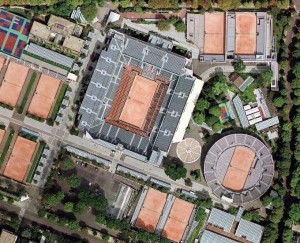By Sidney Wood
The following is an excerpt from the newly-published memoir of 1931 Wimbledon champion and International Tennis Hall of Fame member Sidney Wood called “THE WIMBLEDON FINAL THAT NEVER WAS…AND OTHER TENNIS TALES FROM BYGONE ERA” ($19.95, New Chapter Press, available for sale here: http://amzn.to/lKh90E)
It is curious to notice that a surprising number of the sport’s all-time greats have the Roland Garros jewel missing from their crown of Grand Slam tournament achievements.

The sluggish courts of crushed red brick at the French Championships have been a frustrating obstacle to master for numerous Hall of Famers and have denied many a tennis legend from entering its winner’s circle. For a number of frequently less renowned French winners, the victory has brought them a slice of tennis immortality, though their basically backcourt play has inhibited their chances at any of the other three faster-court majors.
Because the French Championship has been such a thorn in the side of so many four-Slam aspirants, I’d like to expound a bit on why so many top-ranked stars have failed to make the grade. A victory at Roland Garros is of sovereign importance if one is to attain the Olympian summit of tennis of winning all four major titles in a single year – the Grand Slam – a feat only achieved by two men, first by Don Budge in 1938 and again by Rod Laver in 1962 and again in 1969. For those who might be uncertain why the French is a different ballgame from the other three majors, it should be explained that its playing surface is not what is often mistakenly referred to as “clay” but a fine grit measurably slower-thanits-American-cousin Har-Tru. Roland Garros always played slow, but after a rain shower – Wow!
Multiple major tournament winners thwarted in their quest for the French title include such grass and hard court powerhouses as John Newcombe, Bobby Riggs, Jimmy Connors, John McEnroe, Boris Becker, Stefan Edberg, Pete Sampras and Patrick Rafter; and though I may possibly end up at risk with certain of my peers, I am impelled to hazard these comments as to why certain other high-echelon strivers failed to bring home le jambon.
Connors had marvelously flat and accurate ground strokes, so strong on “normal” surfaces, but at Roland Garros they would lose their zip. Could he have compromised by rolling a few and hanging in there with occasional volleying sallies?
Becker fired nothing but howitzers in France, where everyone gets an extra step to reach their salvos. McEnroe had nearly all it took, but the slow stuff doused much of his first-serve fire and his chip-and-run-in style tended to set him up for passing shots. Edberg and Rafter were both great serve-and-volley whizzes who didn’t get quite enough on their deliveries in Paris to force the floater returns they could put away on grass and hard courts. Stefan made it to a final in 1989 but couldn’t quite muzzle the passing shots of the extraordinary prodigy Michael Chang. Lastly, and particularly puzzling to me, there’s Sampras. Pete’s normally devastating serve and forehand lost a lot of clout on the slow-mo French clay. He was never convinced that no matter how exasperating, it was a no-win game unless he could have cut down the pace and worked the rallies until he got one to clobber or go in on. Losing to Andrei Medvedev in the second round in 1999, Sampras said, “On every surface it’s natural instinct. Sometimes on clay my instinct is not the right call. Maybe it’s best to stay back, maybe it’s best to take a little off my serve and come in on the next shot. I get into a hole, and I want to serve my way out of holes. On clay, you just can’t do that.”
You’ll hear it from past champions who’ve garnered a French victory en-route to other triumphs: until a Grand-Slam event winner hammers out a French win, he hasn’t yet earned the privilege of sharing the unique luster of those who have.
